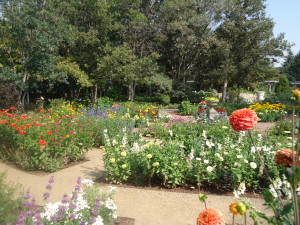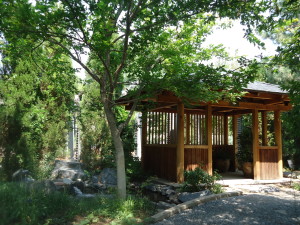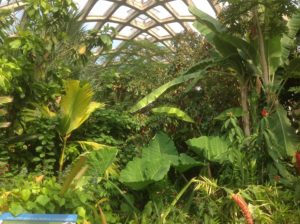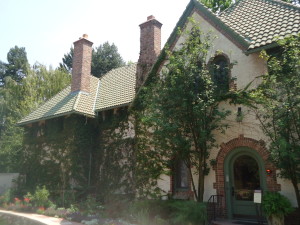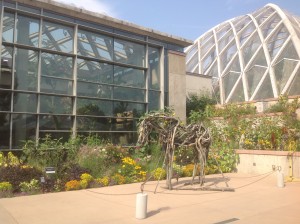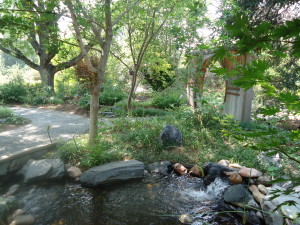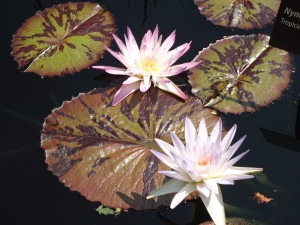Story
Fall in Bloom: History and Art at the Denver Botanic Gardens
Last month I experienced plants, flowers and art in a way I had never before at this stunning oasis in Denver. Its name? The Denver Botanic Gardens. In this enchanting place, everything is a work of art. Every garden, carefully designed, every painting and sculpture on display, every plant they nourish -- each is a work of art. It's obvious that tons of thought and love has been poured into each masterpiece.
So, what are the Denver Botanic Gardens? It's a place where thousands of different species of plants grow. There are many different gardens, each one with its own intriguing theme. Marnie's Pavilion has many tropical plants, while the Bonsai Garden has (surprise!) Bonsai trees. Sculptures and other works of art are displayed throughout the Gardens. It's a fabulous venue for concerts, and weddings, and -- behind the scenes -- it's the perfect place for botanists to conduct research. It is easily the kind of place where you say you'll be there for X number of hours, and you end up staying twice as long.
This amazing sanctuary started out as an idea among some botanists. The idea sprung into action when Denver approved the charter for the future botanical garden on February 3, 1951. The following year, the 100-acre Denver Botanical Gardens (as it was called back then) became a reality in City Park. But they were forced to move the Gardens, as it wasn't safe for the flowers during the night as some people would trample and steal the flowers, coining the term for them "night diggers."
The Gardens were moved to where a cemetery was being removed to create Cheesman Park. Did you know that there are still bodies under the Park? After a big scandal involving moving the bodies, Denver simply built the Park over many of the dead who hadn't been moved, yet. And they never were...today, 23 acres of Cheesman Park are actually the Denver Botanic Gardens.
So, what is there to see at the Denver Botanic Gardens? What flowers are there? What themes of gardens are there? Let me tell you about some of my favorites.
June's Plantasia, or the Chinese Garden, is magnificent. It takes the beauty of the plants as they are and brings them together. One of my favorite things in the garden was the Ting, a small structure similar to a gazebo. "Ting" literally translates to "pause," meaning one would rest in the Ting and pause to reflect and enjoy the scenery. I also loved the Moon Gate, the wooden, door-less doorway that adorns the path one takes through the Chinese Garden. Gates in gardens are very important in Chinese culture. The Moon Gate represents the moon and happiness.
Another one of my favorite gardens was the Bonsai Garden. A Bonsai tree is a tree that has been manicured to keep its unique shape and petite size, not a different type of tree, like is commonly believed. I learned that to create a Bonsai tree, one clips its roots to maintain its petite stature and shapes its roots and leaves to manicure it. The shapes of the Bonsais were out of this world! It's amazing what experts can do.
Similar to the Bonsai Garden is the Japanese Garden. Erin Bird, the Communications Manager at the Denver Botanic Gardens, says this is her favorite garden of the pack. "I love the Japanese Garden because it is an elegant and minimal contrast to the other gardens that feature bright flowers and native grasses," says Ms. Bird. "It is very refined and classic and beautiful all seasons." Featuring Bonsais, as well as many other plants, the Japanese Garden truly is what Ms. Bird loves it for.
But the garden that makes Denver Botanic Gardens truly unique is within the Boettcher Memorial Tropical Conservatory, or rather what was named the Elizabeth Anna Boettcher Tropical Conservatory in 2009 but seems more like -- a rainforest. A strikingly stunning imitation of a real rainforest, the Conservatory helps one really grasp just how beautiful the rainforest is, with its exotic plants for your eyes to feast upon.
I also learned what people mean when they say the rainforest is dense. It's one thing to say it's dense, but it's another to experience the density.
But there's more than just the rainforest -- the building is unique, too! It has cement criss-crossing with plexiglass in the rhombus shapes that the cement forms. Claude Boettcher's company, Ideal Cement Company, helped build it. It was finished and donated to the Gardens in 1966 and was named a Denver Landmark in 1973. It will become a historic landmark next year in 2016!
Another historic building in the Denver Botanic Gardens is the Waring House. The Waring House, built in 1927, was one family's private home until Mrs. Ruth Waring donated it in 1959. It, too, became a Denver Landmark in 1973. It was built in the gorgeous Beaux Arts style, and with its ornate arches, remains a beauty today!
I mentioned that the Denver Botanic Gardens displays art, too. It does, both indoors and outdoors among the flowers. The art showing among the flowers now? Deborah Butterfield's Horses.
When you these beauties, one word will pop out of your mouth: "Whoa." These startlingly accurate sculptures are made from various pieces of driftwood Butterfield has found, collected, and connected to resemble horses in pose.
You will say "Whoa" again when you realize that you're not looking at driftwood but bronze painted to deceive and entrance your eye. No joke, Butterfield will find pieces of driftwood in the woods, use those to create the horse, take the horse apart and make identical shapes in bronze, reassemble the horse using the bronze imitations, and paint the horse to make it look exactly like driftwood! Her works will be there until October 18th, so get there soon before her horses travel!
Something I found interesting was the difference between June's Plantasia (the Chinese Garden) and the Japanese Gardens (the Japanese Garden and the Bonsai Garden). The Chinese Garden is wild, thriving in its vibrant simplicity. The Japanese Garden offers a different kind of simplicity, a less busy, more sculpture-like kind of garden. In other words, the Chinese go for as natural as possible, while the Japanese go for as intricate as possible.
But, I loved that while both approaches were very different, both were sophisticated and lovely.
One amazing and unusual thing about the Denver Botanic Gardens is how much it strives to help others and the Earth. It was one the first botanic gardens to be environmentally concerned, which has led it to conserve water, use healthy biological control of bugs and pests, and grow native plants.
The Gardens also has a sister location called Denver Botanic Gardens in Chatfield. "We grow a ton of produce that is sold to the public, donated to homeless shelters and provided at discounted prices to people who live in food deserts [areas of Denver where fresh produce is not easily found]," says Ms. Bird. "We also work with post 9/11 military veterans to help them readjust to civilian life and learn agricultural skills."
I called everything at the Denver Botanic Gardens a work of art. My hope is that with this article, people will understand why I call it that. My definition of art is pretty broad, and that definition includes beautiful arrangements of flowers, elegant sculptures, structures representing a culture, and marvelous historic buildings. If you don't believe me, go to the Gardens, and enjoy the art and beauty surrounding you.


